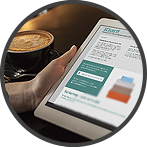Two tricks for remembering your new to-do list
Datum: 2025-11-05 09:08

A common trap some of my clients fall into when they set up their to-do list in a new app is that they forget they have it. Until now they have, like so many others, scattered notes about what they have to do in many places but to make their work life dramatically easier, they have collected all the to-do tasks into a single list. They put the list in a digital tool that is new to them. It can be the Tasks function in Outlook, Microsoft To-Do, Todoist, Asana, Notion, or any other of the countless list tools available.
For you who prefer listening to reading, this post is also available as an episode of the ""Done!"" podcast:
The list becomes something extra, something unusual and odd
Everything starts off well, but then they are hit by the reality of everyday life. They have so much to do, and get so many emails and chat messages. Without thinking much about it, they do what they come to think of, what comes up and what comes in, because they no longer happen to see all the tasks that were previously right in front of them — written on notes, in meeting notes, or at the top of the pile of papers. All the tasks are now in the new list, which seems more and more remote. To get there, they need to remember to go there, log in, and start the application.
“Help! The list!”
Eventually, they realize that they also have a to-do list with lots of tasks to be done — in addition to everything that flows in from all directions. They already have tasks that have passed the deadline and they are cursing themselves for not remembering to use the new list — the one that was so good and well organized.
When this is the case, they would benefit from helping themselves remember that it is now the new to-do list they should consult for what to do. Luckily, there are tricks for this as well.
Here’s how
As I see it, if the situation I described sounds familiar, you can do two things to remember to use your new to-do list:
- First, make sure that there are no tasks elsewhere, and that everything is gathered into this single list. If you have some other tasks — perhaps the most urgent ones — in a more accessible place, chances are you will consult this extra location and never actually get to the real list. On the other hand, if you let the new list be complete and the only place for your to-do tasks, there is no doubt that this is where you will go to choose things to do. You will almost be forced to “go there” a few times daily.
- Make sure you cannot avoid seeing your new list tool. You can:
The full effect of structuring
Not until you make it easier for yourself to remember your new to-do list will you experience the full effect you wanted, which was the reason you made the change in the first place. You will have better control over your work situation and you can rest assured you have not missed or forgotten anything. Even if you cannot do everything you would like to do, you can clearly see what you will not be able to do instead of getting unpleasant surprises when others remind you of something you forgot having promised.
How do you do it?
How did you manage to quickly get used to a new to-do list? Write and tell me. I’m all ears and curious about what you have to share.
(Do you want to work more efficiently with your to-do list? Do short tasks first when the to-do list is long!)
There are more structure tricks to discover!

If you want more tips on how to create good structure at work, there are many ways to get that from me - in podcasts, videos, books, talks and other formats.




